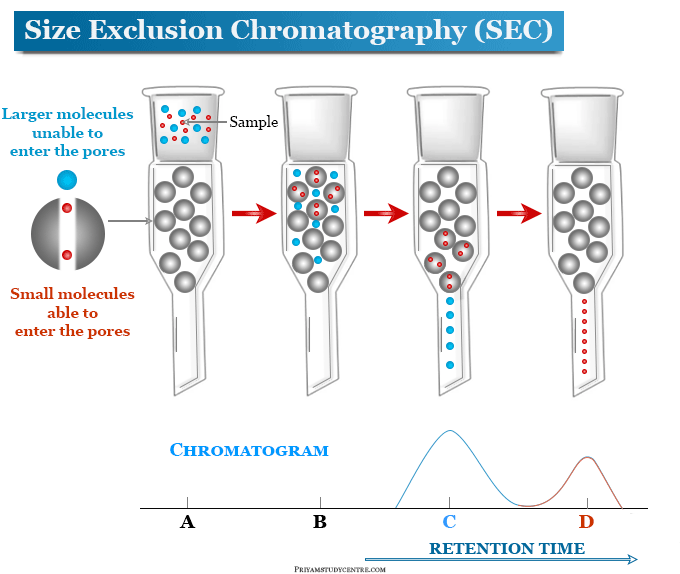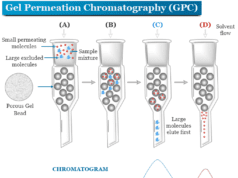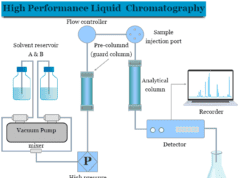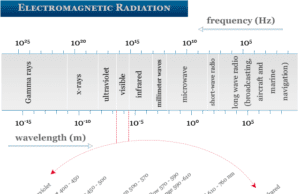Size Exclusion Chromatography Instrumentation
Size exclusion chromatography (SEC) is a chromatographic separation procedure that separates analyte molecules according to their size or geometry and some cases by their molecular weight. The size exclusion chromatography principle or instrumentation uses a chromatography column for the separation of macromolecules like proteins, enzymes, antibodies, nucleic acids (DNA and RNA), and industrial polymers. The size exclusion chromatography principle is based on the exclusion of analyte molecules through a column containing porous beads. When we use an aqueous solution for the transportation of samples through the column, the procedure is called gel-filtration or gel permeation chromatography.

Size Exclusion Chromatography Column
The size exclusion chromatography column contains a porous matrix of spherical particles or beads. Generally, SEC chromatographic columns are composed of dextran polymers (Sephadex), agarose (Sepharose), or polyacrylamide (Sephacryl or BioGel P).
Column Packaging
Two types of column packaging are used mostly in the size exclusion chromatography (SEC) procedure.
- Porous glasses or silica.
- Cross-linked organic gels such as dextran polymers, agarose, polyacrylamide, etc.
The choice of packaging on the column in size exclusion chromatography largely depends upon the molecular size and chemical properties of the samples that we want to separate. For example, Bio-Gel 0-10 operates for samples with molecular weight between 5000 to 17000 units.
In a conventional SEC column, the eluent is allowed to flow under gravity. The flow rate through the column increases with an increase in particle size. For smaller size particles, the flow rate will be lower.
The flow rate is further affected by the particle nature and porosity of column beds used in size exclusion chromatography.
| Material | Trade name | Molecular mass limit (Da) |
| Dextran | Sephadex G-10 | 0 to 700 |
| Sephadex G-25 | 1000 to 5000 | |
| Sephadex G-50 | 1500 to 30000 | |
| Sephadex G-75 | 3000 to 70000 | |
| Sephadex G-100 | 4000 to 150000 | |
| Sephadex G-150 | 5000 to 300000 | |
| Sephadex G-200 | 5000 to 800000 | |
| Polyacrylamide | Bio-gel P-2 | 100 to 1800 |
| Bio-gel P-6 | 1000 to 6000 | |
| Bio-gel P-60 | 3000 to 60000 | |
| Bio-gel P-150 | 15000 to 150000 | |
| Bio-gel P-300 | 16000 to 400000 | |
| Agarose | Sepharose 2B | 2 x 106 to 25 x 106 |
| Sepharose 4B | 3 x 105 to 3 x 106 | |
| Sepharose 6B | 104 to 20 x 106 |
Each size exclusion column given above the table has a range of molecular weights for the separation or purification of proteins or biopolymers.
- The exclusion limit for the upper molecular weight of the analyte trapped in the stationary phase or chromatographic column.
- The lower range provides the molecular weight of the molecules which is small enough to enter all pores of the stationary phase.
Size Exclusion Chromatography Principle
The size exclusion chromatography (SEC) principle is based on high-performance liquid chromatography (HPLC) techniques which contain porous particles in the column to separate molecules by their size or molecular weight. SEC principle is used mostly to separate biological molecules or determine molecular weight distributions of proteins and peptides. It is also used to separate a long list of water soluble industrial polymers.
SEC technique is used mainly for the analysis of large molecules such as proteins, peptides, or industrial polymers.
Size exclusion chromatography instrument works by trapping smaller molecules in the pores of the chromatographic column.
- Molecules that are larger than the pores are unable to defuse on the beads. Therefore, they are eluate first.
- Smaller molecules penetrate deep inside the pores and they are eluate last.
The process is usually performed within a column that contains a hollow tube tightly packed with polymer beads with different pore sizes.
Larger sample molecules flow through the column more quickly than smaller molecules. Hence the smaller molecules have a longer retention time. Like ion-exchange chromatography, retention time decreases with an increase in particle size.
Size Exclusion Chromatography Procedure
The size exclusion chromatography procedure has been divided into the following categories,
- Gel permeation or gel filtration procedure
- Ion exclusion procedure
- Inorganic molecular sieves
Gel Permeation or Gel Filtration Procedure
Gel filtration or gel termination procedure fractionates substances according to their molecular size. It is based upon the inclusion and exclusion of solutes through a stationary phase containing a heterosporous crosslinked polymeric gel.
Ion Exclusion Procedure
Ion exclusion is a procedure for separating ionic materials from nonionic materials by differences in the distribution of two types of solutes between an ion exchange resin phase and a true aqueous solution.
Inorganic Molecular Sieves
Natural and synthetic zeolites are used in inorganic molecular sieves for the separation of gases and smaller organic compounds. A definite mass of zeolite contains a large number of cavities connected by channels. Screening and sieve action of these channels are used to separate molecules smaller than the size of the channel. Unsaturated materials can be removed from refinery and synthetic gases by this procedure.
Applications
Applications of SEC give great advantages in the separation or purification of biomolecules. Therefore, the SEC instrument is used for the separation of sugars, polypeptides, viruses, proteins, enzymes, hormones, antibodies, nucleic acids (DNA and RNA), etc.
The main application of SEC is to separate or analysis of proteins and other water-soluble polymers from their mixture. It is also used to examine the stability and properties of natural organic matter present in water.
Protein Purification by Size Exclusion Chromatography
A series of chromatographic processes are used for the purification of one or more proteins from a complex mixture.
Gel filtration or gel permeation chromatography is one such size-exclusion procedure used for the purification of proteins according to their sizes. It is used to analyze molecules according to their molecular weight. The primary application of size exclusion chromatography in the biopharmaceutical industry is to monitor protein aggregation.
Molecular Weight Determination
Another application of the SEC procedure is to analyze a mixture of molecules of different molecular weights. It is also used to separate molecules of the same molecular weight by proper selection of gel type and column height.
Deselecting
Deselecting is another application of the SEC procedure. It involves the removal of inorganic and ionizable species from biological macromolecules. For example, hemoglobin can be separated from sodium chloride by the Sephadex gel column.
Biopharmaceutics Application
Biopharmaceuticals are complex medicines or pharmaceutical drugs obtained from living cells or organisms. They can be produced by using different types of biotechnological methods.
The size exclusion chromatography instrumentation principle or procedure is used extensively for the development and purification of such biopharmaceuticals.








